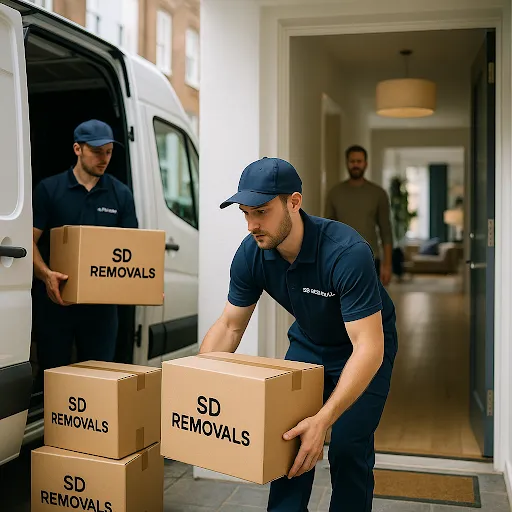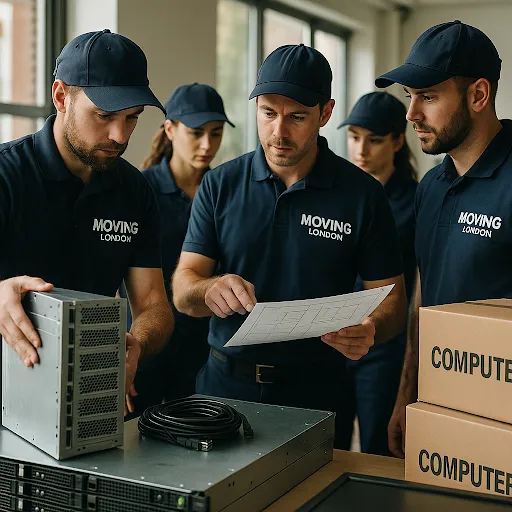TL;DR / Key Takeaways
- Moving an office in London doesn’t have to be expensive—smart planning and local movers make all the difference.
- Book 2–4 weeks in advance to avoid peak prices and protect IT systems.
- Major cost factors: office size, access, IT handling, storage, and packing.
- Declutter before moving—it saves money on storage and clearance.
- One provider handling packing, IT, storage, and clearance keeps costs down and avoids stress.
- Evening and weekend moves are common to cut downtime.
- Selling or donating old furniture can offset moving costs.
- SD Removals offers tailored, insured, 24/7 London office moves with IT support.
Moving Offices in London Without Breaking the Bank
Let’s be honest, moving to an office in London can feel like a headache waiting to happen. You’re juggling IT, furniture, paperwork, and the clock ticking on downtime. The good news? With the right people on your side, the process doesn’t have to cost the earth or drag on for weeks.
I’ve seen businesses of all sizes pull off smooth moves, and the trick usually comes down to smart planning, not massive budgets.
The Big Picture
If you only remember three things, make it these:
- Book a mover at least a couple of weeks ahead (so you’re not stuck with last-minute “peak” prices).
- Don’t underestimate the cost of IT relocation it’s usually the priciest and riskiest bit.
- A single company that packs, moves, stores, and clears saves you money and sanity.
So, What Makes a London Move “Affordable”?
It’s not about going with the cheapest quote on Google. Affordable means efficient. Think about it: local movers who know city permits, who can shift things after hours, who’ve done this a hundred times before that’s where savings show up.
For instance, SD Removals doesn’t just throw stuff in a van. They’ll tailor the whole thing, work evenings or weekends, and keep everything insured. That’s value
What Do Movers Actually Do?
Most people assume it’s just boxes and vans. In reality, you’ll usually get:
- A quick survey of your office.
- Proper labeling and packing so things don’t vanish.
- Help with taking furniture apart and putting it back together.
And if you want extras: IT setup, storage, clearance, or even recycling. Honestly, bundling it all with one company saves a lot of faff.
Costs: The Honest Bit
Here’s where everyone perks up. Costs swing wildly depending on office size, access (tight staircases can add hours), and IT kit.
Some rough numbers:
- A small van-and-man can be about £55 an hour.
- Storage hovers around £18 a week.
Watch out for sneaky add-ons like weekend surcharges or extra labor. My tip? Declutter before you move. I’ve watched companies spend more storing old chairs than they were worth.
Choosing the Right Partner
Forget glossy brochures, what you really want is proof. Have they handled IT moves before? Do they have insurance paperwork ready? Can they show you real reviews?
Compare a few quotes, ask for a written plan, and make sure they’ll answer the phone outside office hours. Those details matter more than a shiny website.
The Actual Moving Process
Every company has its way, but here’s how it usually flows:
- You decide what’s moving and when.
- They pop in for a survey.
- A move plan comes together (especially for IT switchover).
- Packing happens label everything or you’ll regret it.
- On the big day: load, transport, unload.
- IT goes back in, furniture is rebuilt, the office slowly feels like home again.
- Quick inspection and a sigh of relief.
Small offices can wrap up in a few days. Big HQ moves sometimes drag across weekends or even months in phases.
IT and Data: Handle With Care
Let’s not sugarcoat this messing up IT can shut down a business. Plan cutover windows, run test switches, and keep IT staff handy. And yes, data protection rules (like those from the ICO) apply even when you’re just moving a server across town.
Also: Don’t forget to recycle old kit securely. Chain-of-custody matters more than people think.
Storage and Clearance: Keep or Toss?
Not everything deserves a new desk in your shiny office. Storage can be a quick fix, but weigh the cost carefully. Sometimes selling old desks or donating them is smarter. I’ve seen firms actually earn back part of their moving bill this way.
Real-World Stories
- A fintech I know shifted from coworking to a private office in one night. They booked an evening IT cutover and avoided downtime completely.
- A multinational split their HQ move across three weekends, phasing IT step by step. Painful planning, but it worked.
- A law firm downsized, sold their spare desks, and nearly covered clearance costs. Smart move.
Why SD Removals?
Because they don’t just move desks, they move businesses. 24/7 slots, scalable teams, IT know-how, and no hidden nasties in the quote. Honestly, that’s what peace of mind looks like during a move. Get a survey and quote from SD Removals
FAQs (The Stuff Everyone Asks)
How far in advance should I book?
At least 2–4 weeks; longer for big moves.
Do movers pack and unpack?
Yes, packing is common. Unpacking is usually an add-on.
Can IT equipment be moved safely?
Yes, choose a mover with IT specialists and a clear plan.
Are storage options available?
Yes, starting around £18 per week.
Can moves happen outside office hours?
Absolutely. Evening and weekend moves are common.
What happens to old furniture?
It can be resold, donated, or recycled landfill is the last option.






